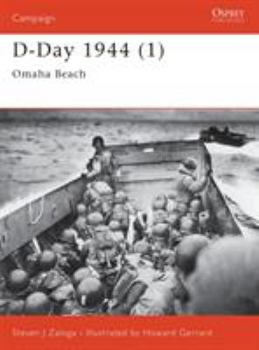D-Day 1944: Omaha Beach, #1
(Part of the Osprey Campaign (#100) Series, D-Day 1944 (#1) Series, and Osprey Campaign (#100) Series)
Select Format
Select Condition 
Book Overview
The first title in Osprey's survey of the D-Day landings of World War II (1939-1945). The D-Day landings of 6 June 1944 were the largest amphibious military operation ever mounted. The greatest armada the world had ever seen was assembled to transport the Allied invasion force across the Channel and open the long-awaited second front against Hitler's Third Reich. Of the landings on the five assault beaches, Omaha Beach was the only one ever in doubt. Within moments of the first wave landing a third of the assault troops were casualties. Yet by the end of D-Day the Atlantic Wall had been breached and the US Army's V Corps was firmly entrenched on French soil.
Format:Paperback
Language:English
ISBN:1841763675
ISBN13:9781841763675
Release Date:July 2003
Publisher:Osprey Publishing (UK)
Length:96 Pages
Weight:0.71 lbs.
Dimensions:0.3" x 7.3" x 9.7"
Customer Reviews
1 rating
A Fresh Look at a Well-Known Subject
Published by Thriftbooks.com User , 21 years ago
The Battle of Gettysburg and the landings on Omaha Beach are two of the most covered subjects in American military history, and readers should approach any new books on these subjects with a great deal of caution. ... As usual, Zaloga does not disappoint and he is able to present a few facets of a well-known operation that are ignored in other accounts. In fact, Zaloga did considerable research at the National Archives and the Army War College library, which enabled him to do far more than merely summarize secondary sources. Omaha Beach starts with a well-written introduction and chronology, followed by sections on opposing commanders (much better than in previous Zaloga volumes), and a 16-page section on opposing plans that is very interesting. The 6-page section on opposing armies is decent, although perhaps not as in-depth as some readers would like. The 45-page campaign narrative is well written and focuses primarily on the events on D-Day itself, devoting only a few pages to the expansion of the beachhead in the week after the invasion. Zaloga also includes a section on the battlefield today and an annotated bibliography. The maps are quite good in this volume and include four 2-D maps (German forces around Omaha, the assault landing plan, V Corps D-Day objectives, and V Corps D-Day operations) and three 3-D Bird's Eye View maps (the 16th RCT sector, the 116th RCT sector and Point du Hoc). The three color battle scenes by Howard Gerrard are: landings on Easy Red Beach, Dog Red Beach and Rangers at Point du Hoc. In addition, Zaloga has combed the NARA archives for some photographs that go beyond the standard D-Day images. Indeed, Zaloga consistently demonstrates that a good author can make even a well-worn topic seem fresh. Zaloga clarifies a number of interesting but obscure points about D-Day. While several sources note Major General Corlett's suggestion to use amtracs as in the Pacific invasions, few follow this tantalizing lead. Zaloga notes that, "in fact, the US Army had shipped over 300 amtracs to Europe in 1944, but the lack of demand for their use in the Overlord plan meant that they were reserved for Operation Swordhilt, a contingency operation in which Patton's uncommitted Third Army was intended to reinforce Overlord in the event of failure at one of the beaches." Zaloga, the armor expert, also adds a great deal of clarity to the role of US tanks on Omaha Beach. Most sources tend to suggest that the majority of the armor foundered in the English Channel and thus the role of tanks was negligible. Zaloga points out that both DD and tanks with wading trunks were used, as well as Sherman dozer tanks. Although many of the DD tanks sank, enough of the tanks with wading trunks made it ashore to play a decisive role in silencing the German resistance nests. Furthermore, the popular idea that arrogant American commanders spurned the use of Britain's specialized armored engineer tanks is disputed by Zaloga; the V Corps did





